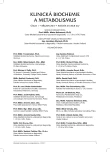Intoxication with ethylene glycol and falsely increased plasma lactate concentration
Authors:
J. Racek 1; V. Petříková 1; D. Rajdl 1; I. Novák 2
Authors‘ workplace:
Ústav klinické biochemie a hematologie
1; I. interní klinika Lékařské fakulty UK a Fakultní nemocnice v Plzni
2
Published in:
Klin. Biochem. Metab., 25, 2017, No. 1, p. 32-35
Overview
Objective:
To describe a patient intoxicated with ethylene glycol and to show possible problems of delayed diagnosis due to interference of ethylene glycol oxidative products in lactate determination.
Design:
Case report and evaluation of laboratory results.
Settings:
Department of Clinical Biochemistry and Hematology and Ist Department of Internal Medicine, Faculty of Medicine, Charles University and Faculty Hospital, Alej Svobody 80, 304 60 Pilsen (Czech Republic).
Material and Methods:
Case report.
Results:
The paper describes a patient intoxicated with ethylene glycol including diagnostic consideration, worsened by falsely increased concentration of lactate, measured amperometrically using blood-gas analyzers.
Conclusion:
Products of ethylene glycol oxidation (glycolic and glyoxylic acids) are the cause of falsely increased concentration of lactate when measured by a lactate enzymatic electrode with lactate oxidase and amperometric detection.
Keywords:
ethylene glycol, glyoxylate, lactate, interference.
Sources
1. Krifta, P.: Etylenglykol. In: Akutní intoxikace v intenzivní medicíně. Grada Publishing, Praha, 2002, s. 136 – 139
2. Pernet, P., Bénéteau-Burnat, B., Varbourdolle, M., Maury, E., Offenstadt, G.: False elevation of blood lactate reveals ethylene glycol poisoning. Am. J. Emerg. Med., 2009, 27, 132.e1 – 132.e2
3. Duncan, R. J. S., Tipton, K. F.: The oxidation and reduction of glyoxylate by lactic dehydrogenase. European J. Biochem., 1969, (11), p. 58 – 61
4. Woo, M. Y., Greenway, D. C., Nadler, S. P., Cardinal, P.: Artifactual elevation of lactate in ethylene glycol poisoning. J. Emerg. Med., 2003, 25(3), p. 289 – 293
5. Citterio-Quentin, A., Chardon, L., Tissier, F., Parant, F., Moulsma. M.: Interférence des métabolites de l´éthylene glycol sur le dosage ampérometrique du lactate sur analyseur ABL 825® Radiometer: àpropos d´un cas. Ann. Toxicol. Anal., 2010, 22(3), p. 109 – 113
6. Graïne, H., Toumi, K., Roullier, V., Capeau, J., Lefèvre, G.: Interférences des métabolites de l´éthylene glycol avec les dosages du lactate. Ann. Biol. Clin., 2007, 65(4), p. 421 – 424
7. Meng, Q. H., Adeli, K., Zello, G. A., Porter, W. H., Krahn, J.: Elevated lactate in ethylene glycol poisoning: True or false? Clin. Chim. Acta, 2010, 411, p. 601 – 604
8. Sandberg, Y., Rood, P. P. M., Russcher, H., Zwaans, J. J. M., Weigel, J. D., van Daele, P. L. A.: Falsely elevated lactate in severe ethylene glycol intoxication. Netherlands J. Med., 2010, 28(7/8), p. 320 – 323
9. Brindley, P. G., Butler, M. S., Cembrowski, G., Brindley, D. N.: Falsely elevated point-of-care lactate measurement after ingestion of ethylene glycol. Canad. Med. Assoc. J., 2007, 176(8), p. 1097 – 1099
10. Morgan, T. J., Clark, C., Clague, A.: Artifactual elevation of measured plasma L-lactate cencentration in the presence of glycolate. Critical Care Med., 1999, 27(10), p. 2177 – 2179
11. Porter, W. H., Crellin, M., Rutter, P. W., Oeltgen, P.: Interference of glycolic acid in the Beckman Synchron method for lactate: An useful clue for unsuspected ethy-lene glycol intoxication. Clin. Chem., 2000, 46(6), p. 674 – 675
12. Manini, A. F., Hoffman, R. S., McMartin, K. E., Nelson, L. S.: Relationship between serum glycolate and falsely elevated lactate in severe ethylene glycol poisoning. J. Anal. Toxicol., 2009, 33, p. 174 – 176
13. Chaudhry, S. S., Pandurangan, M., Pinnell, A. E.: Lactate gap and ethylene glycol poisoning. Eur. J. Anaesthesiol., 2008, 25(6), p. 511 – 513
14. Verelst, S., Vermeersch, P., Desmet, K.: Ethylene glycol poisoning presenting with a falsely elevated lactate level. Clin. Toxicol. (Phila), 2009, 47(3), p. 236 – 238
15. Tintu, A., Rouwet, E., Russcher, H.: Interference of ethylene glycol with L-lactate measurement is assay-dependent. Ann. Clin. Biochem., 2013, 50, p. 70 – 72
16. Reference manual for ABL800 FLEX (Radiometer), kap. 5, s. 5-95
17. Operator´s Manual for GEM® Premier 2500 (Instrumentation Laboratory), kap. 11, s. 11.6 – 11.8
Labels
Clinical biochemistry Nuclear medicine Nutritive therapistArticle was published in
Clinical Biochemistry and Metabolism

2017 Issue 1
Most read in this issue
- Mild Hyperhomocysteinemias From Deficiency of MTHFR (C677T and C1298A) in Adults and Adolescents Attending Metabolic Unit: Is There Any Necessity for Their Differentiation and Treatment?
- Intoxication with ethylene glycol and falsely increased plasma lactate concentration
- Nutrition and metabolism of the bone
- Relationship between cold water swimming and increased cardiac markers: A pilot study
